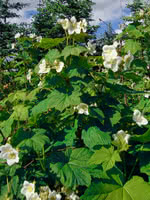Mon-Fri 9am - 5pm Mountain time
Thimbleberry vs American Black Currant
Ribes americanum
Rubus parviflorus
CUSTOM GROW
NOT AVAILABLE THIS SEASON - MIGHT RETURN
American Black Currant is a native deciduous shrub known for its clusters of small black berries that ripen in mid-to-late summer. The berries are edible and have long been used for fresh eating, preserves, and baking. They provide food for birds and mammals, and their fragrant spring flowers attract bees and other pollinators.
American Black Currant’s foliage serves as a host plant for butterfly species such as the Green Comma and Gray Comma, and its dense branching offers cover for wildlife. The shrub has traditionally been planted in shelterbelts, riparian buffers, and restoration projects.
Thimbleberry is an ornamental shrub with large, green maple-like-leaves. Flowers are attractive, fragrant, and turn into red-raspberry-like berries. The berries are good for jams, cakes, breads, muffins etc. If you remove the berry, the core resembles a thimble, giving this shrub its namesake.

